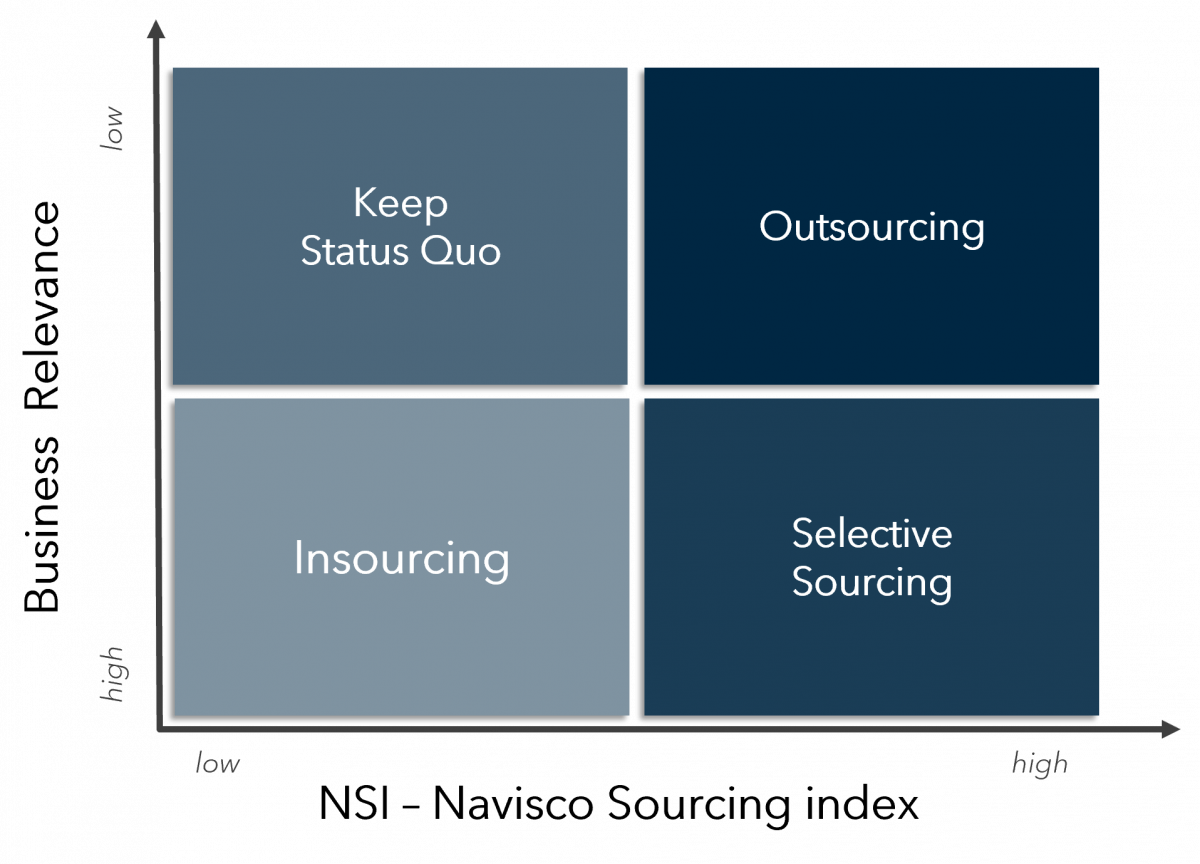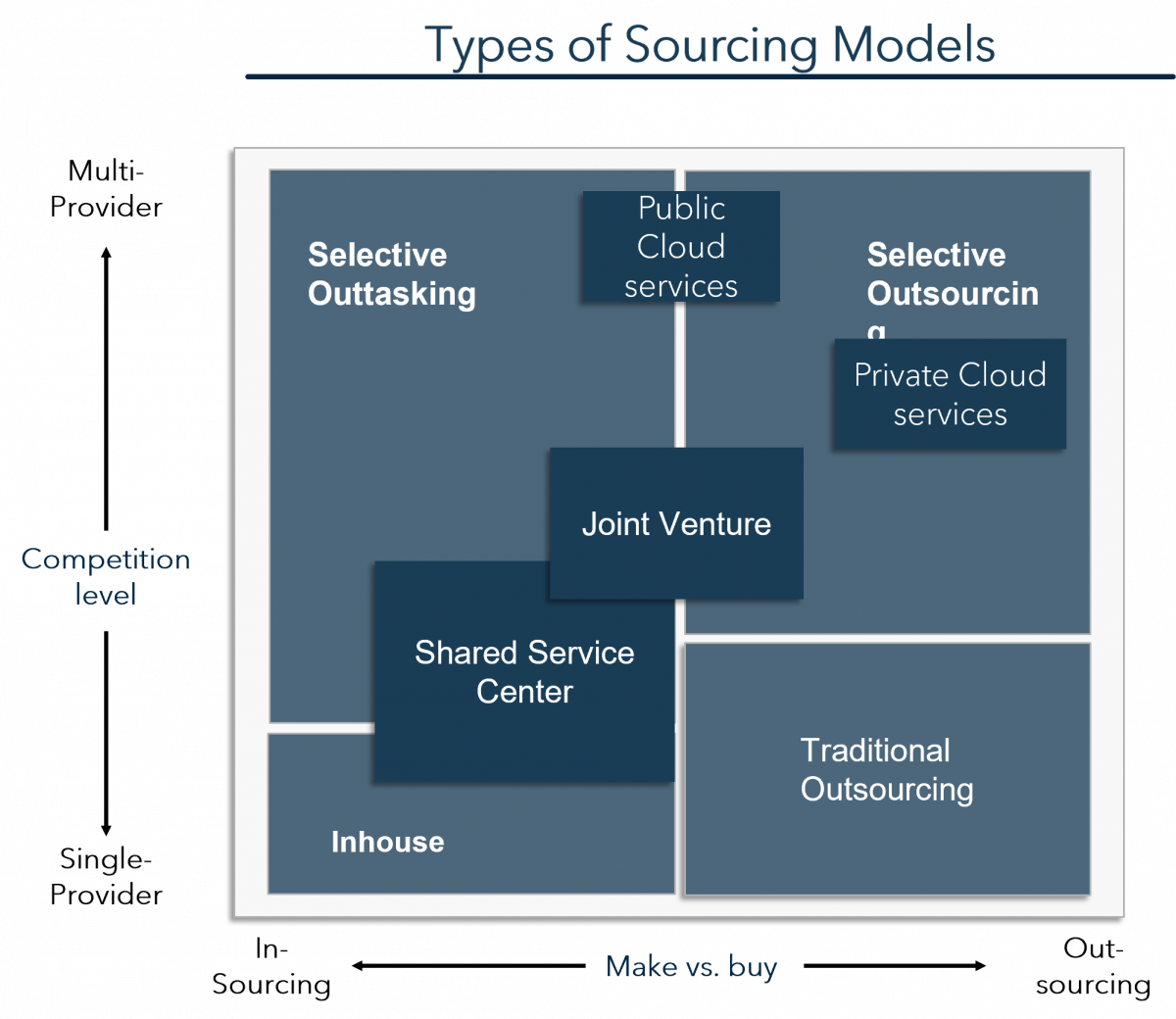Since the end of the 90’s Navisco AG consults in the development and implementation of sourcing strategies and outsourcing implementations both in IT infrastructure, application management and specific business processes (BPO). From Navisco’s point of view, the experiences of our international customers in Germany, Switzerland, Austria over the 10 years can be evaluated very differently regarding the achieved goals. This experience report is intended to highlight the positive as well as negative aspects and success factors in the creation and implementation of a sourcing strategy and to provide clear instructions for the execution of a sustainable and successful outsourcing project.
Goals and requirements from the business strategy
The starting points for the development of a sourcing strategy must always be the company’s business strategy and business objectives. This is the only way to ensure consistent value creation and avert potential damage to the business. For example, a company that is growing dynamically through international acquisitions has fundamentally different requirements than a company that is developing organically with established business. The topics of flexibility, contract model, governance and price model can be solved in very different ways in the sourcing strategy.
From our experience, the vast majority of outsourcing strategies pursue standardization and transformation to a more efficient operator model in the future in cooperation with the so-called “delivery units” worldwide (near-shore, offshore) in order to achieve better cost/performance ratios. Most customers are thus pursuing an efficiency-oriented sourcing strategy (see Figure 1). Although cost considerations are still the primary focus of interest in most cases, the topics of effectiveness, especially in the sense of increased process control and simplified harmonization of heterogeneous environments, as well as architecture design have also gained considerably in importance. The topic of generating competitive advantages is a business strategy topic and represents the link to the sourcing strategy, e.g., with increased flexibility for the business units.
Another key question is the maturity of the organization in terms of documented, lived, and managed business processes. If the company has a high degree of maturity in this respect, it makes sense to align the sourcing strategy and its implementation with the requirements and key figures of the business processes. Where this environment does not exist, the sourcing strategy will be based on the given infrastructure or applications. This is then the consideration level for the creation of the sourcing strategy.
Core competencies and market potential
An important part of the sourcing strategy is the identification and description of the individual services or service modules in line with the market as well as the core competence analysis of the own company or division. Based on this, a well-founded estimation of both the qualitative and financial potentials per module is necessary in order to start a possible request for proposal (RFP) process. This is where the greatest risk for the customer lies, both in the cutting of services and in the estimation of realistic targets in terms of savings areas and qualitative performance. Misunderstood objectives of top management, self-interest of the organization and lack of or current experience on feasibility with comparable processes and providers are the most common cause of expensive failures and failures after 1-2 years in outsourcing. Last but not least, this is a highly political discussion that requires a certain independence and experience as well as the commitment of top management.

The different options for action are presented in the form of a sourcing portfolio (see Figure 1). The Sourcing Portfolio combines an analysis of business relevance or core competencies with the Sourcing Index at the respective level of consideration. The Navisco Sourcing Index (NSI) combines market and business factors and provides benchmarking potentials according to realistic assessments of the current service market. The result is clear recommendations that describe cost, performance and quality aspects compared to the current state.
The sourcing and governance model
In order to realize the identified sourcing potentials, various sourcing models are to be evaluated as options for action, depending on the objectives and the maturity level of the organization (see Figure 3). . In addition, the cuts of the service modules as well as the service depth are already to be described in a rough sourcing model. These recommendations for action provide the framework for drawing up individual contract and service agreements (SoS) and service levels (SLA) at a later stage.

In particular, the future delivery and service model must be defined in the sourcing model of the strategy from a governance and control perspective, as this has a significant influence on the service qualities and prices in outsourcing.
Implementation and communication plan
Finally, the implementation plan is an essential part of the sourcing strategy. Here, unrealistic time targets or expectations often have an impact on the quality of contracts and services. In practice, realistic implementation cycles in a competitive process to contract signature are 6 to 12 months. Questions of sustainability of savings in the pricing model or questions of contract creation and negotiation must already be defined in the sourcing strategy. Also, the selection of potential service providers according to defined criteria and matching the developed sourcing strategy is an essential step. Without certainty as to whether appropriate outsourcing partners on the market have both interest and demonstrable competencies for the relevant services, the sourcing strategy remains theory.
Conclusion
The result of a sourcing strategy is always highly individual and its development is a complex undertaking. From our reviews and audits we know that unfortunately not every sourcing strategy and its implementation is successful. Often, significant risks and potential problems can already be found in the sourcing strategy and implementation planning. Based on our experience, we would like to summarize the following success factors:
- Communication: Realistic expectations through active involvement of business units and top management regarding goals and framework conditions as well as proactive involvement of employees.
- Experience: A solid set of methods and sourcing reference model as well as a broad range of experience regarding implementation
- Independence: Distance and independence from the affected organization and the provider market to address critical issues and challenge assumptions
- Culture: Consideration of the maturity level of the organization, the corporate culture as well as the medium-term corporate development
- Implementation planning: Stringent process with sufficient time reserves in implementation planning, based on experience from other tenders and contract negotiations in outsourcing
To reduce risks and ensure implementation success, it is always recommended to clarify the strategic issues and framework conditions in the form of a sourcing strategy prior to a tender. The involvement of an external consulting firm with specialized know-how and best practices in outsourcing should be mandatory.



